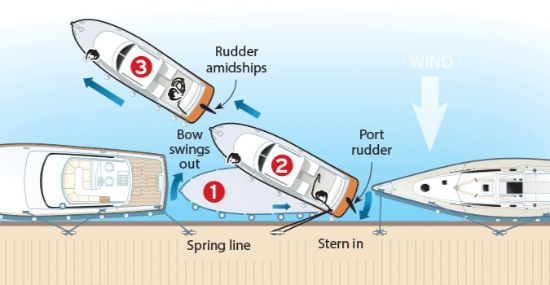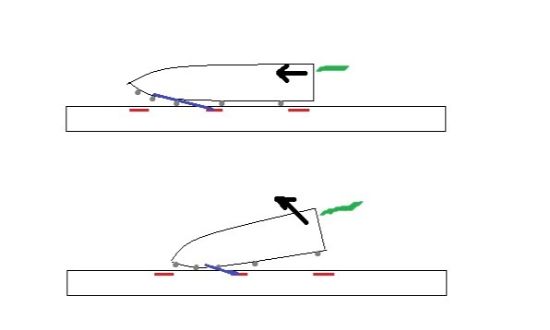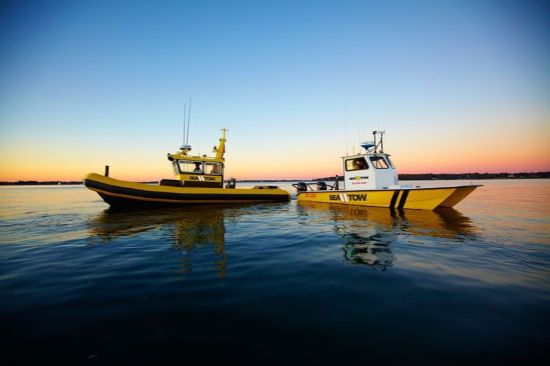Five Tricks All Seasoned Captains Know
If you own a boat, you can legitimately call yourself the captain -- but that doesn’t mean you’re a particularly good captain. Although there’s no substitute for years of experience at the helm, a little bit of knowledge never hurts.
Combining the two is how a good captain becomes a great one. So, if you’re not already familiar with these five boat-handling tricks and tactics, study up. Then afterward, hit the water for some hands-on experience.

#1 Springing a Line
Knowing how to spring out of a slip can save you when a strong wind is holding your boat beam against the dock and you don’t have room fore and aft to maneuver.
The tactic is simple: run a line from a spring cleat (amidships, though in a pinch a bow or stern cleat can be used with a somewhat lessened effect) to a cleat or piling on the dock that’s well aft behind the boat.
With the line secured, that spring cleat becomes your pivot-point. Put the boat into forward gear with the wheel turned away from the dock, and the bow will turn out and away from the dock while the line prevents your boat from moving forward. How much power you need to apply is a matter of overcoming the wind. But in any case, after applying enough juice to get the bow swung sufficiently far away from the dock, you can slip the line free and power forward.
In extremely tight quarters, or when you may not have dock cleats in the ideal positions, remember that as the bow swings out, the stern will want to swing in. Whenever you spring a line, it’s a good idea to post a deck or dockhand nearby with a fender, ready to slide it between the pier and the boat.

Small boats that don’t always carry fenders can accomplish the same thing with an extra life jacket. Springing a line can also be done in reverse (just run the line forward instead of aft) when this may be necessary to get your boat off the dock.

#2 Jumping on Plane in Shallows
Anglers who fish the shallows will sooner or later find themselves in a situation where there’s enough water under the keel to float and it’s deep enough to run, but there isn’t enough depth to get the boat from displacement mode up to on plane.
You’ve probably noticed that when power is applied to a boat, the stern digs in as the propeller digs a hole and the boat’s bow rises. On many boats, this increases draft by a good six or eight inches. As soon as the prop digs into the bottom, all thrust gets lost. Assuming you didn’t damage anything, you’re back to square one.
The solution –- for single engine boats only -- is to cut the wheel hard-over in one direction or the other, before applying power. When you nail the throttle, the boat will immediately begin to bank into a turn, bringing the lower unit significantly higher than it would otherwise be. As soon as the boat starts to plane in a tight circle, crank the wheel back to straight and you are home-free.
Warning: before attempting this maneuver, warn everyone aboard and secure all of your gear. Otherwise, people and things will go flying when you nail the throttle and go into an instant turn.

#3 Surfing the Boat
When you’re trying to get a small boat in through an inlet with large waves, surfing is often the safest bet. Instead of overtaking the waves, which will cause you to then fall into a trough, if you can match the wave’s speed you can ride it for quite a distance. This is just a matter of jockeying the throttle to maintain the proper speed and is something you can only do by feel. The real trick, however, is transitioning from surfing one wave to surfing another.
Waves merge, dissipate, and otherwise disappear from beneath your boat no matter how well you may be matching their speed. When one does disappear and you feel your boat sinking into a trough, the most important thing to remember is to accelerate.
It’s always better to overtake a wave than it is to be overtaken by a wave — the bow is much better at handling rising water than the stern is — and if you slow down instead of speeding up a wave could overtake you from astern. So as soon as you’re no longer up on a wave, accelerate to catch up to and begin surfing on the next one.

#4 Opposing Powerplants
Obviously, this trick only applies to twin-engine boats. If you do have twins, however, getting a feel for opposing the engines is incredibly important for slow-speed maneuvering. You can control a boat far more easily with opposed engines than you can with the steering wheel. The biggest mistake most captains make when maneuvering a twin-screw boat is grabbing the wheel and turning the engines off-center.
Instead, force yourself not to touch the wheel. Use the throttles only and you’ll find that after a little practice you can control your boat better than ever.
One caveat: the closer the engines are to each other, the less effective opposing becomes. As a result, the closer they are to one another the more power you’ll need to apply to have the desired results.

#5 Jumping Ship (And onto Another)
Usually, when someone needs to get from one boat to another while on open water, one boat pulls up next to the other and everyone tries to hold the boats close, as people step across. But try this in seas of any size, and you’ll learn that two things happen.
First, the wind and waves turn the boats on their beam. Second, once the waves start hitting the boats on the beam one rocks while the other rolls. One gunwale goes up, the other goes down, and you’d better pray that no hands or feet get in between them as people cross from one boat to the other or someone’s getting hurt.
A much better way to transfer passengers is to keep both boats moving forward at minimal speed, directly with or into the seas. Whether to head into them or go with them is a judgment call; so long as the waves aren’t large enough to be threatening if they approach from the stern, going with the seas is generally better.
Keeping both boats moving at the same speed in the same direction means that the waves hit them both at the same time and have the same basic effect on both boats. Instead of the gunwales grinding in different directions they’ll stay more or less parallel, and your passengers can make a safe crossing.
Caveat: We do not recommend jumping from boat to boat in anything except a flat calm. There are simply too many things that can go wrong, even in mild chop. A slip, a fall between boats coming together, can be tragic.